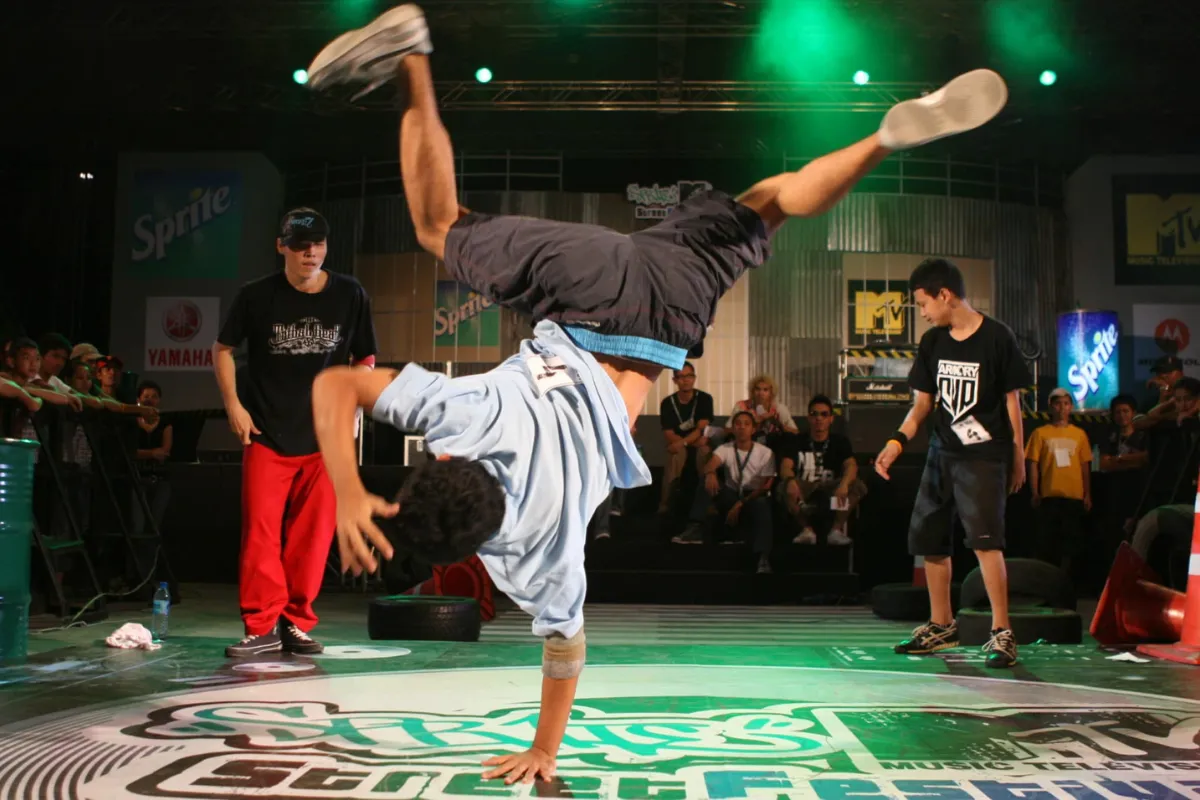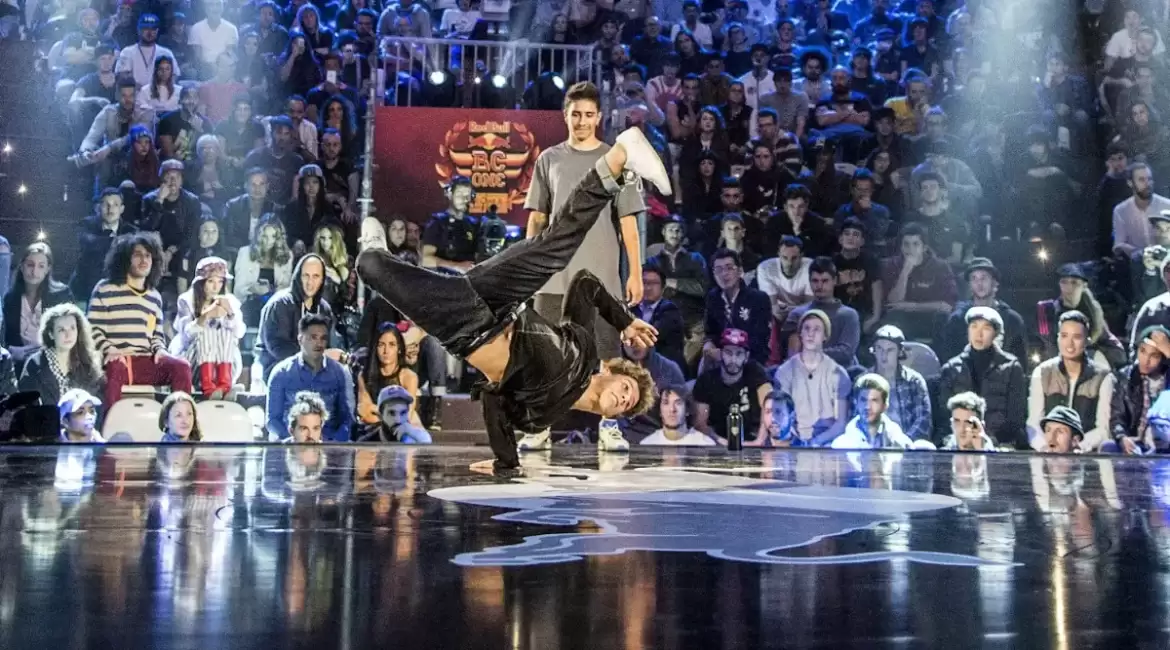What is a breaking battle? A breaking battle is a competitive showdown between two breakers (commonly known as b-boys or b-girls), where they take turns showcasing their skills, creativity, and style through dance. These battles typically occur within the context of hip-hop culture and are often accompanied by energetic music, primarily funk, breakbeat, or hip-hop tracks.During a breaking battle, each participant has the opportunity to perform a series of moves, including footwork, freezes, and power moves, while incorporating their own unique style and expression. The goal is to impress judges and spectators with their mastery of the dance form, musicality, and stage presence.Breaking battles can occur in various formats, including one-on-one battles, crew battles (where teams of breakers compete against each other), or even large-scale competitions such as international tournaments or showcases.
In the electrifying arena of one-on-one breaking battles, two breakers engage in a rhythmic showdown, each striving to outshine the other with their prowess, creativity, and flair. As they trade moves, showcasing their unique style and musicality, the judges keenly observe, preparing to render their verdict once all rounds are completed. Yet, behind the flashy displays lies a strategic dance of tactics employed by b-boys and b-girls, crucial in shaping the battle’s ultimate outcome. In this article, let’s explore some fascinating information about The Art of Battle: Breaking Competition Strategies with Learn Breakdance.
To start or not to start?

The breaker initiating the battle issues a bold challenge to their opponent, declaring, “Let’s see if you can respond to this.” They seize the opportunity to make the initial impression on the judges, setting a benchmark that their adversary must match. By taking the lead, a b-boy or b-girl establishes the standards of stage presence, athleticism, musicality, and difficulty, placing pressure on their opponent to rise to the occasion.
This strategic move allows the initiating breaker to potentially overshadow their opponent’s performance before they even step onto the dance floor. For instance, if the opening breaker exhibits greater dynamism, musicality, and charisma, their counterpart’s round may appear inferior across these key elements of breaking. Consequently, the initiator appears stronger, amplifying the challenge for their opponent to excel in subsequent rounds.
Moreover, this tactic can also serve as a personal strategy. Breaking battles often evoke nerves and adrenaline in competitors, prompting some to opt for the first position to quell overthinking and fully immerse themselves in the moment. For these individuals, leading off enables them to transition into battle mode swiftly, unleashing their optimal performance.
However, there are also notable advantages to allowing the opponent to go first. When a b-boy or b-girl assumes the second position, they gain the advantage of observing their opponent’s moves before formulating their response. This grants them the opportunity to assess their repertoire of moves and determine which ones are most effective in matching or surpassing their opponent’s performance.
Additionally, there’s the benefit of flexibility if the opponent makes a mistake or crashes during their routine. The second breaker can then decide whether to take a calculated risk and execute ambitious moves or opt for a safer approach to showcase cleaner movements.
For those who have never faced their opponent before, going second provides valuable insight into their opponent’s style, moves, and character, enabling them to tailor their strategy accordingly.
Furthermore, considering the musical aspect, if a breaker is unfamiliar with the DJ’s track or isn’t vibing with the music, going second allows them more time to connect with the rhythm and integrate it into their moves seamlessly.
Personal strategy also plays a significant role here. Some breakers may find the pressure of going first overwhelming and prefer the opportunity to respond rather than setting the initial tone of the battle.
In competitions, it’s not uncommon for both breakers to prefer going second, resulting in a tense standoff at the outset of the battle as both dancers await the other to make the first move. This dynamic is often observed in events like the final battle of Red Bull BC One 2018.
Mind games: gestures, trash talking and burns

A crucial aspect of breaking strategy involves disrupting your opponent’s focus and composure, aiming to instill doubt in their skills and performance abilities. When they become nervous, it becomes significantly easier to outshine them.
Utilizing familiar gestures to indicate to their opponent that they’ve faltered in some manner. Examples include:
- Tapping the floor, signaling that their opponent has crashed or failed to execute a move.
- Displaying a count with fingers in the air, indicating to the audience and judges that the opponent is repeating previously performed moves. In breaking battles, repetition is typically discouraged.
- Slowly clapping hands to the beat of the music in a mocking manner, indicating that their opponent is dancing offbeat, out of sync with the rhythm. This gesture suggests that the opponent is so rhythmically off that they require assistance to find the tempo.
- Pointing to their ears to signify that the opponent is not attuned to the music.
- Mimicking the action of writing in an imaginary notebook, symbolizing that the opponent is merely executing preplanned sequences instead of improvising in response to the current music.
Trash talking in breaking battles is a less common but still present aspect compared to gestures and burns. It involves directly confronting the opponent with jibes such as labeling them ‘off-beat,’ accusing them of repetitive moves, criticizing their routines as ‘wack,’ or pointing out mistakes and crashes. It’s not merely criticism; it’s an effort to destabilize the opponent’s confidence, disrupt their concentration, and assert psychological dominance.
Burns, on the other hand, are subtle actions or interactions aimed at diminishing the opponent’s confidence or causing embarrassment. There are various types of burns in breaking, but a simple example is feigning a handshake only to retract it as the opponent reaches out, or mimicking the opponent’s dance style in an exaggerated, humorous manner.
These psychological tactics are employed to disrupt the opponent’s focus and performance. However, if your skills don’t match your opponent’s and you attempt these tactics, it can backfire, making you appear overly confident and leaving a negative impression.
Going all out versus saving moves

Some breakers enter competitions with the deliberate strategy of unleashing all their best moves right from the start, regardless of their opponents. Even when facing adversaries they believe they can confidently defeat, they refuse to hold back. This approach is grounded in the belief that only the current round holds significance, as there’s no guarantee of advancing to the next battle. However, this tactic carries the inherent risk of depleting their repertoire of moves prematurely, potentially leaving them with fewer options later on. They might find themselves resorting to repetition, freestyling, or employing lesser-utilized, untested moves in their arsenal as the competition progresses.
Conversely, there are competitors who opt to reserve their best moves for the toughest opponents or for later rounds in the competition. By doing so, they ensure that they still have their most potent maneuvers in reserve for crucial battles, such as the final showdown or encounters with formidable opponents. Yet, this strategy is not without its drawbacks. There’s a risk of underestimating opponents in the early stages of the competition, potentially resulting in unexpected losses. Moreover, there’s the possibility of failing to advance past the qualification stage if they withhold their best moves, delivering a subpar performance that fails to impress judges.
posing your opponent’s weakness

For breakers equipped with a diverse range of moves, a strategic approach involves showcasing to the judges what their opponent lacks, thus exposing weaknesses or missing elements in their breaking style.
For instance, if a competitor predominantly focuses on power moves without integrating musicality, footwork, or dancing into their routine, their opponent might opt to incorporate a blend of power moves with intricate footwork, expressive dancing, and synchronization to the music. By doing so, they effectively highlight the contrast between their opponent’s limited repertoire and their own multifaceted skill set.
Conversely, if an opponent excels primarily in top rock and footwork, their adversary may mirror these skills while also incorporating power moves, innovative transitions, and unique freezes. This approach not only demonstrates the opponent’s strengths but also emphasizes the additional elements they lack.
By demonstrating a mastery of various aspects of breaking with high-quality execution, breakers significantly increase their chances of victory by showcasing a broader range of skills than their opponents.
Conclusion
These aforementioned tactics represent just a few of the myriad strategies employed by breakers in their quest to gain an edge over their opponents on the battle floor. Delving into these intricacies underscores the depth and complexity of breaking competitions, where every move, gesture, and decision carries strategic significance. Thank you for engaging with this exploration of breaking competition strategies. Your attention is appreciated!


Leave a reply